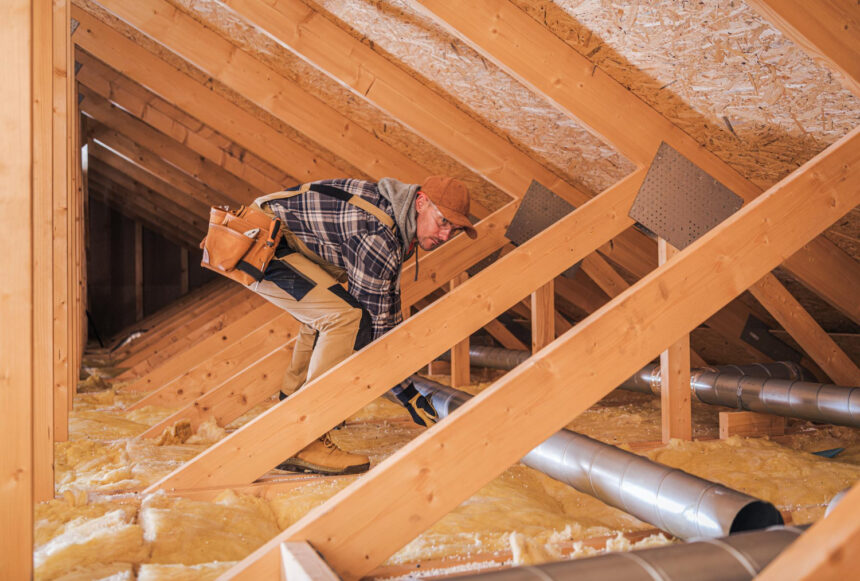Loft insulation plays a crucial role in maintaining an energy-efficient home. Proper insulation can significantly reduce heat loss and lower heating bills, making it a smart investment for homeowners. Different types of loft insulation, such as cold and warm roof options, can fit various needs and budgets. Understanding the right choice for a specific situation is essential for optimizing energy savings.
The installation process of loft insulation is straightforward enough for many to tackle as a DIY project. With the right materials and tools, anyone can take steps to improve their home’s energy efficiency. Additionally, following proper maintenance practices can ensure that insulation lasts for decades, providing ongoing benefits.
The growing focus on energy conservation has led to legislative changes that promote better insulation standards. Homeowners can benefit from being informed about these regulations, enhancing both comfort and compliance.
Benefits of Loft Insulation
Loft insulation offers multiple advantages that significantly improve household comfort, reduce energy costs, and benefit the environment. Each benefit is crucial for homeowners considering this upgrade.
Energy Efficiency
Loft insulation plays a vital role in enhancing energy efficiency in homes. It acts as a barrier, limiting heat transfer between the inside of the house and the outside. This helps maintain a consistent indoor temperature. With proper insulation, homes can stay warm during winter and cool in summer without relying heavily on heating or cooling systems.
A well-insulated loft can reduce heat loss by about 25%. This means that homeowners won’t have to work as hard to keep their homes comfortable, leading to less energy being consumed. Overall, better energy efficiency lowers carbon footprints and contributes to a more sustainable lifestyle.
Cost Savings
Cost savings are one of the most compelling reasons to consider loft insulation. By keeping homes warmer during colder months, insulation reduces reliance on heating systems. This leads to lower energy bills. Homeowners can save approximately £110 each year, depending on their energy use and existing insulation.
In addition to reduced bills, loft insulation is a long-term investment. The initial cost may seem high, but the savings on energy bills accumulate over time. Homeowners often recoup their investment within a few years due to these ongoing savings.
Environmental Impact
Loft insulation also has a positive environmental impact. By improving energy efficiency and reducing heat loss, it helps decrease overall energy consumption. This can lead to a reduction in carbon emissions associated with energy production.
Moreover, less energy use means fewer natural resources need to be tapped. By upgrading to proper loft insulation, homeowners contribute to sustainability efforts. It helps in fighting climate change by minimizing the ecological footprint of their home.
Implementing loft insulation means both financial and environmental benefits can be realized simultaneously, making it a smart choice for many homeowners.
Types of Loft Insulation
There are various types of loft insulation available. Each type has its own features, benefits, and methods of installation. Understanding these options is essential for making an informed choice.
Blanket or Matting Insulation
Blanket or matting insulation is commonly made from materials like fiberglass, rock wool, or mineral fiber. It typically comes in rolls or batts, making it easy to install between joists.
This type is favored for its cost-effectiveness and accessibility for DIY projects. One major benefit is its flexibility in covering different shapes and sizes of spaces.
Blanket insulation is efficient for thermal resistance, helping to keep homes warm in winter and cool in summer. It also has a soundproofing quality that can reduce noise levels in a home.
Loose-Fill Insulation
Loose-fill insulation consists of small particles of insulation material such as fiberglass, cellulose, or foam. It is often used in areas that are hard to reach or have irregular shapes.
Installation involves blowing the material into the space, allowing it to settle and fill voids. This provides excellent coverage and minimizes air gaps that can lead to heat loss.
Loose-fill insulation is effective for controlling moisture and reducing noise. It is less common for DIY installation, as it often requires specialized equipment.
Sheet Insulation
Sheet insulation comes in large panels or sheets made from material like foam board or fiberglass. It is typically used in areas with specific insulation needs, such as around ducts or in walls.
This type provides a high insulation value with fewer seams, which helps to reduce the risk of thermal bridging. It is also lightweight, making it easier to handle and install.
Installation can be done using adhesives or mechanical fasteners. Sheet insulation is beneficial for new builds or renovations where airtight conditions are essential.
Blown-Fiber Insulation
Blown-fiber insulation uses loose particles made from materials like cellulose or fiberglass. This type is installed by blowing the fibers into the desired area, which allows it to conform to the space.
It is particularly useful for retrofitting existing homes where traditional batt insulation may not fit well. Blown-fiber insulation provides high coverage and can fill gaps effectively.
This insulation option also offers decent sound dampening and moisture control. Installation typically requires professional equipment for optimal results and efficiency.
Installation Process
The installation process for loft insulation involves several key steps. Proper preparation is essential before starting, whether choosing a DIY approach or hiring professionals. Safety should also be a top priority at all stages of the installation.
Preparation Steps
Before beginning the insulation process, preparation is crucial. First, the workspace must be cleared of any items in the loft. This includes old boxes, tools, or debris that could obstruct the installation.
Next, gather all necessary tools and materials. Commonly needed items include:
- Insulation rolls or batts
- Utility knife or handsaw
- Stapler and staples
- Measuring tape
- Ladder
It’s important to measure the joists’ height to select the correct thickness of insulation. For instance, if joists are 100mm high, it’s advisable to use insulation that matches this thickness. Ensuring proper ventilation is also key. Leave a 25mm gap from the eaves when installing insulation.
Professional Vs. DIY Installation
Choosing between professional installation and a DIY approach depends on several factors. Professional installers have experience and knowledge that can save time and prevent errors. They typically ensure the insulation is installed correctly, maximizing energy efficiency.
DIY installation can be a cost-effective option for those who are handy and want to save money. However, beginners should be aware of potential challenges, such as correctly measuring and cutting insulation. Using the right tools can simplify this process, but mistakes could lead to reduced effectiveness of the insulation.
It is advisable to assess personal skills and comfort before deciding. If a homeowner has doubts about their ability, hiring a professional may be the best option.
Safety Considerations
Safety is a vital aspect of the installation process. Before starting, it is important to wear protective gear. This includes:
- Safety goggles
- Gloves
- Dust mask
These items help protect against dust and debris that may arise during installation. Ensure that the loft is well-ventilated to avoid inhaling harmful particles.
When using a ladder, it needs to be stable and positioned on a level surface. Avoid leaning too far to prevent falling. If any electrical fittings are exposed, it’s wise to turn off power to avoid accidents. Keeping safety as a priority will result in a safer, more efficient installation process.
Maintenance and Lifespan
Proper maintenance is crucial for maximizing the lifespan of loft insulation. Regular inspections and timely repairs can prevent issues that lead to early deterioration. Homeowners should familiarize themselves with key maintenance practices and be aware of signs indicating that insulation may need replacement.
Inspection and Upkeep
To keep loft insulation effective, regular inspections are essential. Homeowners should check insulation at least once a year. During inspections, look for signs of moisture, pests, or any physical damage.
Key areas to evaluate include:
- Moisture Accumulation: Check for damp spots that can lead to mold growth.
- Pest Damage: Look for droppings or nests that indicate infestations.
- Physical Condition: Ensure insulation materials remain intact without holes or compressions.
If any issues are found, address them promptly. Replacing damaged sections or improving ventilation can help maintain insulation performance and prolong its life.
Signs of Deterioration
Recognizing signs of deterioration is vital for maintaining loft insulation. Common indicators include:
- Reduced Energy Efficiency: Higher energy bills can point to insulation failure.
- Cold Spots: Noticeable cold areas in the house may signal poor insulation.
- Mold or Mildew: Visible signs of mold suggest moisture issues, which can damage insulation.
Homeowners should act quickly if they notice these signs. Early intervention can prevent costly repairs and increase the lifespan of the insulation, ensuring it remains effective for years. Regular maintenance and awareness of these signs will help protect the investment made in loft insulation.
Legislation and Standards
Loft insulation must comply with specific building regulations and standards to ensure safety and energy efficiency. Understanding these requirements helps homeowners make informed decisions about energy-saving improvements.
Building Regulations
Building regulations set the minimum standards for loft insulation in homes. These rules help ensure safety, energy efficiency, and comfort.
Key points include:
- Thermal Performance: New insulation must achieve a U-value of at least 0.16 W/m²K. This is often met with around 250mm of mineral wool insulation.
- Existing Insulation: If the current insulation has a U-value worse than 0.35 W/m²K, it may need replacing or topping up.
Homeowners must check local regulations for details. Compliance is crucial for safety and may affect resale value.
Insulation Grants and Incentives
Various programs offer financial assistance for loft insulation improvements. These incentives aim to promote energy efficiency and reduce fuel costs.
Homeowners may benefit from:
- Government Grants: Programs like the Energy Company Obligation (ECO) provide funding for eligible households to improve insulation.
- Tax Credits: Some regions offer tax incentives for homeowners who invest in energy-efficient upgrades.
It is essential to research local options to maximize potential savings. This financial support can significantly reduce the cost of making a home more energy-efficient.




